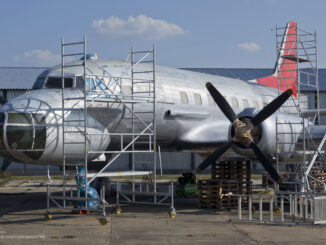 Aero L-39ZA Albatros (c/n 232409, formerly ´109´ of the Romanian Air Force, N214AX, Airborne Tactical Advantage Co. Ltd), static display at Phantom Pharewell event, Wittmundhafen, June 2013.
Aero L-39ZA Albatros (c/n 232409, formerly ´109´ of the Romanian Air Force, N214AX, Airborne Tactical Advantage Co. Ltd), static display at Phantom Pharewell event, Wittmundhafen, June 2013.
Only three years after introducing Aero L-29 Delfín, the first Czechoslovak-designed jet aircraft, works on its successor were launched. Similarly to the L-29, the new training aircraft was expected to be used by most of the Eastern Bloc countries, therefore it was not surprising that its framework characteristics were defined by the Soviet Union authorities. Then, in 1964, the detailed specification of the new trainer was included in Czechoslovak military requirement designated C-39 and development of the aircraft was assigned to a team of constructors from Aero Vodochody company, led by Jan Vlček.
On 4th November 1969, prototype of the new trainer performed its maiden flight. Evaluation of four prototype aeroplanes lasted until the end of 1970. Serial production was launched next year, and the aircraft was officially designated L-39C Albatros (C stands for cvičný – training).
Similarly to its predecessor, the L-39 was a single-engine, low-wing jet aircraft, featuring a double cockpit with seats in tandem configuration. The aircraft was powered by a derivative of Ivchenko AI-25 twin-shaft jet engine, made by Motorlet Jinonice. Robust design of its undercarriage and low landing speed made the L-39 capable of operating from austere airfields. A special emphasis was also placed on ease of maintenance and service.
Although the main idea was to create the successor for the L-29, the new aeroplane was also designed as a light attack jet, able to perform a variety of close air support missions. The first combat-capable variant of the Albatros, designated L-39ZO, performed its maiden flight in 1975. The aircraft was equipped with four hardpoints under its wings and was mainly intended for foreign customers. The full light attack version was introduced in 1977, named L-39ZA and, in addition to the abovementioned hardpoints, equipped with GSh-23 cannon.
Production of the L-39 was continued until 1996 with approximately 2,900 examples built. Some of the latest variants of the aircraft were made with use of Western avionics, such as the L-39Z/ART for the Royal Thai Air Force that was equipped with Israeli-made electronics and onboard systems.
As expected, the L-39 Albatros shortly became the standard training aircraft of the Warsaw Pact countries (except Poland, that never adopted Czechoslovak trainers and stayed with domestically made TS-11 Iskra) and was acquired by other Eastern Bloc countries. The light attack variant gained popularity in countries of the Third World that could not afford to purchase any full-scale combat jet aircraft.
That, together with dissolution of the Soviet Union and local conflicts that followed, resulted in the L-39 Albatros having an impressive combat history. It includes War in Abkhazia, Afghan civil war, Nagorno-Karabakh War, Chechen Wars, Chadian-Libyan War, Syrian civil war and several other small conflicts in Africa and Asia.
Worldwide reduction of air forces that followed the end of Cold War caused that many examples of the L-39 came to the civilian market. The training variants became the only second-generation jet aircraft available for non-military operators. Only in the United States, there is over two hundred L-39s registered, they are also flying in Canada, Australia or New Zealand.
The L-39 Albatros was, and in some cases still is, being used by several civil and military aerobatics teams all over the world. Among them there were Patriots Jet Team (USA), Breitling Jet Team (France), Biele Albatrosy (Slovakia), Baltic Bees (Latvia) and Russ (Russia).
The Czechoslovak trainer is just as popular among private companies providing tactical training for military and defence industry, as independent contractors. Those ´aggressor squadrons´ often fly with the L-39ZA, the light attack variant of the Albatros, but usually upgraded to meet demands of modern air combat.
One of such private contractors is the Airborne Tactical Advantage Company (ATAC), from Newport News in Virginia, USA. In June of 2013, one of their L-39ZA aircraft was exhibited on the static display during the German F-4 Phantom fighters retirement event – and that´s exactly the date and place our current Photo of the Week was taken.



